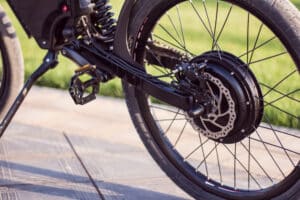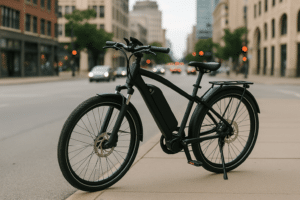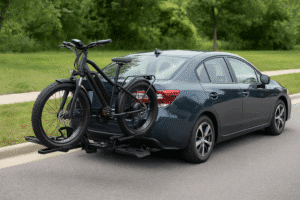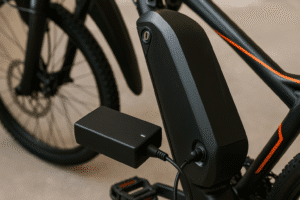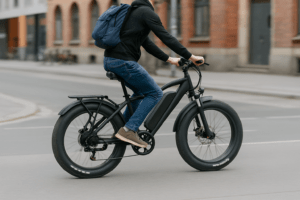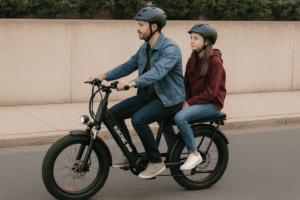If you’re wondering how fast a 48V electric bike can go, you’re not alone. Speed is one of the first things people ask when comparing e-bikes.
I’ve tested and researched dozens of models, and in this article, I’ll break down the real numbers based on motor size, road conditions, and rider experience.
TL;DR
A 48V electric bike can reach speeds between 20 and 35 mph, depending on the motor wattage, terrain, and setup.
- 500W to 750W motors: up to 28 mph
- 1000W to 1500W: around 30–35 mph
- 2000W or higher: possible 40+ mph, but often not street-legal
Factors like rider weight, wind, and controller settings also affect speed. While 48V systems are faster than 36V, most areas limit e-bike speeds to 28 mph for legal use. You can go faster with mods, but it comes with trade-offs.
How Fast Does a 48V Electric Bike Go?
Most 48V electric bikes reach speeds between 20 and 35 mph, depending on the motor wattage and how the bike is set up.
To be more specific, bikes with a 500W or 750W motor usually top out around 20 to 28 mph.
Higher-wattage motors, like 1000W or 1500W, can push that speed closer to 30 or even 35 mph on flat ground.
With a 2000W or 3000W setup, it’s possible to hit 40 mph or more, though that’s not always legal for public roads.
From what I’ve seen firsthand, controller settings, terrain, and rider weight also make a big difference. Some bikes are capped for safety or to meet local e-bike laws, while others are unlocked for higher speed. I’ll go over all of that below.
48V Electric Bike Speed by Motor Wattage
The motor wattage has a direct impact on how fast your 48V e-bike can go. Here’s what you can expect at different power levels.
500W to 750W Motor
These are the most common motor sizes in entry-level and mid-range e-bikes. A 48V 500W setup usually tops out at around 20 to 24 mph. If the bike is tuned well or using pedal assist, a 750W motor can hit 26 to 28 mph on flat roads.
I’ve ridden a few 750W models that felt fast enough for daily commutes. They climb hills decently and don’t eat through the battery too quickly.
Most are still classified as legal e-bikes under U.S. Class 3 rules if they’re capped at 28 mph with pedal assist.
1000W to 1500W Motor
This range delivers noticeably more torque and top speed. A 1000W or 1500W motor on a 48V system can reach 30 to 35 mph, especially if you’re riding on a smooth, flat surface.
These bikes are great for heavier riders or off-road use. I’ve used a 1000W fat tire bike for trail riding, and it had no problem keeping a strong pace uphill.
Keep in mind, not all of these bikes are street-legal depending on where you live.
2000W to 3000W+ Motor
If speed is what you’re after, this range is where things get serious. A 48V 2000W or 3000W motor can push speeds over 40 mph, sometimes close to 45 mph. But at that point, you’re really looking at electric dirt bikes or mopeds, not standard e-bikes.
These high-powered setups often require registration or a special license. They’re best suited for private land, trails, or areas where high-speed e-bikes are allowed.
I don’t recommend these for casual riders or city commuting unless you know your local laws.
What Affects the Top Speed of a 48V E-Bike?
Even with the same battery and motor, not all e-bikes will go the same speed. Here are the key factors that influence performance:
- Rider weight: Heavier riders will naturally reduce top speed, especially on hills.
- Terrain: Flat roads allow higher speeds, while steep climbs slow things down.
- Wind resistance: Strong headwinds can cut your top speed by several miles per hour.
- Tire type and pressure: Fat tires or low pressure = more rolling resistance.
- Motor type: Mid-drive motors usually perform better on hills than hub motors.
- Controller limits: Some bikes are programmed to cap speed to meet e-bike laws.
- Battery state: A fully charged battery delivers peak voltage. As it drains, speed can drop.
I’ve noticed that even small adjustments, like properly inflating the tires or switching to a more aerodynamic riding position, can make a measurable difference in real-world speed.
48V vs 36V E-Bike: Does Voltage Really Matter for Speed?
A 48V e-bike is usually faster than a 36V one, especially under load or when climbing hills. The higher voltage delivers more power to the motor, which translates to quicker acceleration and a higher top speed.
That said, wattage and controller output matter too. Here’s a quick comparison:
| Feature | 36V E-Bike | 48V E-Bike |
| Typical Top Speed | 15–22 mph | 20–35+ mph |
| Common Wattage | 250W – 500W | 500W – 1500W+ |
| Climbing Performance | Moderate | Stronger torque |
| Acceleration | Slower | Faster |
| Best For | Light city use, short rides | Hills, commuting, heavier riders |
Are There Speed Limits for 48V Electric Bikes?
Yes, most countries and states have speed limits for electric bikes, regardless of voltage. In the U.S., the legal limit for street-legal e-bikes is typically 20 mph for throttle use and 28 mph when using pedal assist.
Even if your 48V e-bike is capable of going 35 mph or more, that doesn’t mean you’re legally allowed to ride it at those speeds on public roads or bike lanes.
In the U.S., e-bikes are usually grouped into Class 1, 2, or 3, and anything faster may be considered a moped or motor vehicle depending on your state laws.
Some countries, like those in the EU, cap e-bike speeds at 25 km/h (around 15.5 mph), and anything beyond that requires registration, insurance, or a license.
I always tell riders to check their local laws before modifying or unlocking their bike’s speed settings. Getting fined or losing insurance coverage isn’t worth the risk.
Can You Make a 48V E-Bike Go Faster?
Yes, you can increase the speed of a 48V e-bike by upgrading certain components or adjusting software settings, but doing so may affect safety, battery life, and legal compliance.
If you know what you’re doing and understand the risks, here are a few ways to make your 48V e-bike go faster:
- Upgrade the controller: A controller with a higher current limit (amps) can deliver more power to the motor.
- Use a higher amp battery: A 48V battery with higher amp output can improve torque and top-end speed.
- Remove speed limiters: Many e-bikes have a software or wiring cap that restricts speed. Removing it may unlock full motor output.
- Switch to thinner, high-pressure tires: These reduce rolling resistance and help you maintain speed.
- Tune the pedal assist system: Adjusting PAS settings can give more power per pedal stroke.
- Reduce weight: Less weight on the bike means less strain on the motor, which can slightly improve top speed.
- Change the gearing: On some bikes, fitting a larger front chainring can increase your pedaling speed at higher gears.
Just keep in mind, making these changes can void your warranty and might put you outside legal limits for bike lanes or public roads.
Final Words
A 48V electric bike can go pretty fast, typically between 20 and 35 mph, depending on the motor size, bike setup, and terrain. With a 750W motor, you’re likely looking at speeds around 28 mph, while a 1500W or higher setup can take you beyond 35 mph if unrestricted.
That said, speed isn’t everything. Laws in many areas cap how fast you can legally ride, and safety should always come first.
From my own experience, it’s better to have a smooth, reliable ride than squeeze out a few extra miles per hour and risk overheating your system or breaking the rules.
Whether you’re commuting, trail riding, or just cruising for fun, knowing what your 48V e-bike can actually do, and what’s allowed, helps you make better choices.
FAQs
How fast is a 48V 750W e-bike?
A 48V 750W e-bike typically goes around 26 to 28 mph on flat terrain with pedal assist. With throttle only, it usually tops out closer to 20 to 24 mph.
Is 48V better than 36V for speed?
Yes, 48V systems generally offer more power and higher speeds than 36V setups, especially when climbing hills or carrying heavier loads.
Can a 48V e-bike go 40 mph?
It’s possible, but only if paired with a high-wattage motor like 2000W or more. Most stock 48V e-bikes with 750W or 1000W motors won’t reach 40 mph unless modified.
Does higher voltage always mean faster speed?
Not always. Higher voltage can support higher speed, but the actual top speed depends on motor wattage, controller settings, and overall bike tuning.
Is it legal to go over 28 mph on a 48V e-bike?
Not usually. In most areas, riding over 28 mph means your e-bike is no longer street-legal unless it’s registered as a motor vehicle or moped. Always check your local laws.
Michael Josh is a hands-on e-bike tester and reviewer at BoltBikers, known for putting every model through real-world rides before sharing his thoughts. With a sharp eye for performance, comfort, and build quality, he helps the team choose which bikes are worth featuring. Backed by years of experience in tech and gear reviews, Michael brings trusted, honest insights to help readers find the right e-bike for their needs.

